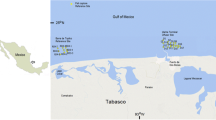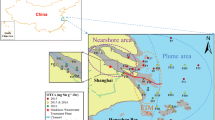Abstract
The fate of carbaryl in the Seto Inland Sea (west Japan) was predicted using a mass distribution model using carbaryl concentrations in river and sea water samples, degradation data, and published data. The predicted carbaryl concentrations in water in Kurose River and the Seto Inland Sea were 4.320 and 0.2134 μg/L, respectively, and the predicted concentrations in plankton, fish, and sediment were 0.4140, 2.436, and 1.851 μg/g dry weight, respectively. The carbaryl photodegradation and biodegradation rates were higher for river water (0.330 and 0.029 day−1, respectively) than sea water (0.23 and 0.001 day−1, respectively). The carbaryl photodegradation rates for river and sea water (0.33 and 0.23 day−1, respectively) were higher than the biodegradation rates (0.029 and 0.001 day−1, respectively). The hydrolysis degradation rate for carbaryl in sea water was 0.003 day−1, and the half-life was 231 days. Land (via rivers) was the main source of carbaryl to the Seto Inland Sea. The model confirmed carbaryl is distributed between sediment, plankton, and fish in the Seto Inland Sea. Degradation, loss to the Open Ocean, and sedimentation are the main carbaryl sinks in the Seto Inland Sea, accounting for 43.81, 27.90, and 17.68%, respectively, of total carbaryl inputs. Carbaryl source and sink data produced by the model could help in the management of the negative impacts of carbaryl on aquatic systems and human health.



Similar content being viewed by others
References
Armbrust KL, Corsby AG (1991) Fate of carbaryl, I-naphthol, and atrazine in seawater. Pac Sci 45(3):314–320
Barragan-Huerta BE, Costa-Perez C, Peralta-Cruz J, Barrera-Cortes J, Esparza-Garcıa F, Rodriguez-Vazquez R (2007) Biodegradation of organochlorine pesticides by bacteria grown in microniches of the porous structure of green bean coffee. Int Biodeterior Biodegrad 59:239–244. https://doi.org/10.1016/j.ibiod.2006.11.001
Bazrafshan AA, Ghaedi M, Rafiee Z, Hajati S, Ostovan A (2017) Nano-sized molecularly imprinted polymer for selective ultrasound-assisted microextraction of pesticide carbaryl from water samples: spectrophotometric determination. J Colloid Interface Sci 498:313–322. https://doi.org/10.1016/j.jcis.2017.03.076
Bidleman TF, Antunen LM, Falconer RL, Barrie LA, Fellin P (1995) Decline of hexachlorocyclohexane in the Arctic atmosphere and reversal of air-sea gas exchange. Geophys Res Lett 22:219–222
Bondarenko S, Gan J, Haver DL, Kabashima JN (2004) Persistence of selected organophosphate and carbamate insecticides in waters from a coastal watershed. Environ Toxicol Chem 23:2649–2654
Carpenter M (1990) Hydrolysis of 14C-carbaryl in aqueous solutions buffered at pH 5, 7 and 9, vol 169-218 # 92535. Department of Pesticide Regulation, Sacramento
Chapalamadugu S, Chaudhry GR (1991) Hydrolysis of carbaryl by a Pseudomonas sp. and construction of a microbial consortium that completely metabolizes carbaryl. Appl Environ Microbiol:744–750
Chapman PM, Ho KT, Munns WR, Solomon K, Weinstein MP (2002) Issues in sediment toxicity and ecological risk assessment. Mar Pollut Bull 44:271–278. https://doi.org/10.1016/S0025-326X(01)00329-0
Chattoraj S, Mondal NK, Das B, Roy P, Sadhukhan B (2014) Carbaryl removal from aqueous solution by Lemna major biomass using response surface methodology and artificial neural network. J Environ Chem Eng 2:1920–1928. https://doi.org/10.1016/j.jece.2014.08.011
Chidya RCD (2018) Occurrence, dynamics, spatio-temporal variations and risk assessment of pesticide residues in Kurose river and Seto Inland Sea. Doctoral thesis, Hiroshima University, Japan pp 98-101
Cullington JE, Walker A (1999) Rapid biodegradation of Diuron and other phenylurea herbicides by a soil bacterium. Soil Biol Biochem 31:677–686
Derbalah AS, Nakatani N, Sakugawa H (2004) Photocatalytic removal of Fenitrothion in pure and natural waters by photo-Fenton reaction. Chemosphere 57:635–644. https://doi.org/10.1016/j.chemosphere.2004.08.025
Derbalah AS, Ismail AA, Shaheen SM (2013) Monitoring of organophosphorus pesticides and remediation technologies of the frequently detected compound (chlorpyrifos) in drinking water. Pol J Chem Technol 15(3):25–34
Derbalah AS, Ismail AA, Hamza AM, Shaheen SM (2014) Monitoring and remediation of organochlorine residues in water. Water Environ Res 86(7):584–593
Derbalah AS, Ismail AA, Shaheen SM (2016) The presence of organophosphorus pesticides in wastewater and its remediation technologies. Environ Eng Manag J 15(8):1777–1787. https://doi.org/10.2478/pjct-2013-0040
Diamond ML, Priemer DA, Law NL (2001) Developing a multimedia model of chemical dynamics in an urban area. Chemosphere 44:1655–1667
Doong R, Chang W (1998) Photoassisted iron compound catalytic degradation of organophosphorous pesticides with hydrogen peroxide. Chemosphere 37:2563–2572
EMECS (Environmental Conservation of the Seto Inland Sea) (2008). Outline of the Seto Inland Sea. Available online at: http://www.emecs.or.jp/englishver2/publication/Seto_Inland_Sea/index.html
EPA (2004) Reregistration eligibility decision for carbaryl. US Environmental Protection Agency, Washington, DC
Finlayson-Pitts BJ, Pitts-Jr JN (1986) Atmospheric chemistry: fundamentals and experimental techniques. Wiley, New York
Hamada M, Matar A, Bashir A (2015) Carbaryl degradation by bacterial isolates from a soil ecosystem of the Gaza Strip. Brazilian J of Microbiol 46(4): 1087–1091. https://doi.org/10.1590/S1517-838246420150177S
Haag RW, Hoigné J (1986) Singlet oxygen in surface waters. 3. Photochemical formation and steady-state concentrations in various types of waters. Environ Sci Technol 20:341–348
Hobbie JE (1988) A comparison of the ecology of planktonic bacteria in fresh and salt water. Limnol Oceanogr 33:750–764
Hoshika A, Shiozawa T, Kawana K, Tanimoto T (1991) Heavy metal pollution in sediment from the Seto Inland Sea. Jpn Mar Pollut Bull 23:101–105
Imai I, Yamaguchi M, Hori Y (2006) Eutrophication and occurences of harmful algal blooms in the Seto Inland Sea, Japan. Plankton Benthos Res 1:71–84
Kaonga CC, Takeda K, Sakugawa H (2015) Antifouling agents and Fenitrothion contamination in seawater, sediment, plankton, fish and selected marine animals from the Seto Inland Sea, Japan. Geochem J 49:23–37. https://doi.org/10.2343/geochemj.2.0327
Kaonga CC, Takeda K, Sakugawa H (2016) Concentration and degradation of alternative biocides and an insecticide in surface waters and their major sinks in a semi-enclosed sea, Japan. Chemosphere 145:256–264. https://doi.org/10.1016/j.chemosphere.2015.11.100
Katagi T (2018) Direct photolysis mechanism of pesticides in water. J Pestic Sci 43:57–72
Keller AA (2007) Steady state and residence time. School of Environmental Science and Management, University of California, Santa Barbara. Available online at: http://www2.bren.ucsb.edu/∼keller/courses/esm202/SteadyState&ResidenceTime.pdf
Kodama T, Kuwatsuka S (1980) Factors for the persistence of parathion, methyl-parathion and fenitrothion in seawater. J Pestic Sci 5:351–355 (in Japanese with English abstract)
Kronvang B, Laubel A, Larsen SE, Friberg N (2003) Pesticides and heavy metals in Danish streambed sediment. The interactions between sediments and water. Dev Hydrobiol 169:93–101
Kuniaki K, Takashi A, Kikuo O, Akiko T (2005) Multiresidue determination of pesticides in sediment by ultrasonically assisted extraction and gas chromatography/mass spectrometry. J AOAC Inter 88:1440–1145
Lacorte S, Barcelo D (1994) Rapid degradation of fenitrothion in estuarine waters. Environ Sci Technol 28:1159–1163
Lee P (2005) Concentrations of pesticides in Sacramento Metropolitan area rainwater during the 2004 orchard dormant spray season. Technical report by staff of the California Regional Water Quality Control Board, Central Valley Region, USA
Looser R, Froescheis O, Cailliet GM, Jarman WM, Ballschmiter K (2000) The deep-sea as a final global sink of semivolatile persistent organic pollutants? Part II: organochlorine pesticides in surface and deep-sea dwelling fish of the North and South Atlantic and the Monterey Bay Canyon (California). Chemosphere 40:661–670. https://doi.org/10.1016/S0045-6535(99)00462-2
Mackay D, Webster E, Cousins I, Cahill T, Foster K, Gouin T (2001) An introduction to multimedia models: a final report prepared as a background paper for OECD Workshop Ottawa, October 2001 (2001) CEMC report no. 200102. Available online at: http://www.trentu.ca/academic/aminss/envmodel/CEMC200102.pdf
MAFF (Ministry of Agriculture, Forestry and Fisheries) Japan (2011) Seto Inland Sea Environmental Protection Work. Available online at: http://www.env.go.jp/council/former2013/11seto/y111-02/mat02_5-1.pdf (In Japanese)
Miller PL, Chin Y (2002) Photoinduced degradation of carbaryl in a wetland surface water. J Agric Food Chem 50:6758–6765. https://doi.org/10.1021/jf025545m
Monsen NE, Cloem JE, Lucas LV, Monismith SG (2002) A comment on the use of flushing time, residence time and age transport time scales. Limnol Oceanogr 47:1545–1553. https://doi.org/10.4319/lo.2002.47.5.1545
Mopper K, Zhou X (1990) Hydroxyl radical photoproduction in the sea and its potential impact on marine processes. Sci 250:661–664
NIES (National Institute of Environmental Studies) (2018) Japan, 2012NIES (National Institute of Environmental Studies) Japan Agricultural Chemicals Database (2018) Available online at: http://db-out.nies.go.jp/kis-plus/index_3.html
Olasehinde EF, Ogunsuyi HO, Sakugawa H (2012) Determination of hydroxyl radical in Seto Inland Sea and its potential to degrade Irgarol IOSR. J Appl Chem 1(5):07–14. https://doi.org/10.9790/5736-0150714
Ramirez-Llodra E, Tyler PA, Baker MC, Bergstad OA, Clark MR, Escobar E, Levin LA, Menot L, Rowden AA, Smith CR, Van-Dover CL (2011) Man and the last great wilderness: human impact on the deep sea. PlOS-One 6:1–25. https://doi.org/10.1371/journal.pone.0022588
Roberts TR, Hutson DH (1999) The agrochemicals handbook; the Royal Society of Chemistry, Information Services. MPG Books, Bodmin
Sabatier P, Poulenard J, Fanget B, Reyss J, Develle A, Wilhelm B, Ployon E, Pignol C, Naffrechoux E, Dorioz J, Montuelle B, Arnaud F (2014) Long-term relationship among pesticide applications, mobility and soil erosion in a vineyard watershed. PNAS 111:15647–15652. https://doi.org/10.1073/pnas.1411512111
Senthilkumar K, Kannan K, Subramanian A, Tanabe S (2001) Accumulation of organochlorine pesticides and polychlorinated biphenyls. Environ Sci Pollut Res 8:35–47. https://doi.org/10.1007/BF02987293
Singh DK (2008) Biodegradation and bioremediation of pesticide in soil: concept, method and recent developments. Indian J Microbiol 48:35–40. https://doi.org/10.1007/s12088-008-0004-7
Stemmler I, Lammel G (2009) Cycling of DDT in the global environment 1950–2002: world ocean returns the pollutant. Geophys Res Lett 36:1–15
Sudo M, Kunimatsu T, Okubo T (2002) Concentration and loading of pesticide residues in Lake Biwa basin (Japan). Water Res 36:315–329
Takeda K, Takedoi H, Yamaji S, Ohta K, Sakugawa H (2004) Determination of hydroxyl radical photoproduction rates in natural waters. Anal Sci 20:153–158. https://doi.org/10.2116/analsci.20.153
Takeda K, Katoh S, Mitsui Y, Nakano S, Nakatani N, Sakugawa H (2014) Spatial distributions of and diurnal variations in low molecular weight carbonyl compounds in coastal seawater, and the controlling factors. Sci Total Environ 493:454–462. https://doi.org/10.1016/j.scitotenv.2014.05.126
Takeoka H (1984) Fundamental concepts of exchange and transport time scales in a coastal sea. Cont Shelf Res 3:311–326
Thuyet DO, Watanabe H, Ok J (2013) Effect of pH on the degradation of imidacloprid and fipronil in paddy water. J Pestic Sci 38(4):223–227. https://doi.org/10.1584/jpestics.D12-080
Tixier C, Sancelme M, Bonnemoy F, Cuer A, Veschambre H (2001) Degradation products of a phenylurea herbicide, diuron: synthesis, ecotoxicity, and biotransformation. Environ Toxicol Chem 20:1381–1389. https://doi.org/10.1002/etc.5620200701
Toose L, Woodfine DG, MacLeod M, Mackay D, Gouin J (2004) BETR-World: a geographically explicit model of chemical fate: application to transport of α-HCH to the Arctic. Environ Pollut 128:233–240. https://doi.org/10.1016/j.envpol.2003.08.037
Trapp S, Matthies M (1995) Generic one-compartment model for uptake of organic chemicals by foliar vegetation. Environ Sci Technol 29:2333–2338
Yamazaki M, Uejima H (2005) World largest scale analog simulator (Seto Inland Sea large sized hydrological model) history and results. Nihon Engan-iki Gakkaishi 18:33–35 (In Japanese)
Zhu SH, Wu HL, Xia AL, Han QJ, Zhang Y, Yu RQ (2008) Quantitative analysis of hydrolysis of carbaryl in tap water and river by excitation-emission matrix fluorescence coupled with second-order calibration. Talanta 74(5):1579–1585. https://doi.org/10.1016/j.talanta.2007.10.002
Acknowledgments
We would like to acknowledge the JSPS for funding an invitation research fellowship to Professor Aly Derbalah at Hiroshima University, Japan. We thank Natalie Kim, PhD, and Gareth Thomas, PhD, from Edanz Group (www.edanzediting.com/ac) for editing a draft of this manuscript. We are also grateful for the support of our laboratory members throughout the study period.
Funding
This research was supported by the Japan Society for the Promotion of Science (JSPS) KAKENHI (grant number 16KT0149).
Author information
Authors and Affiliations
Corresponding author
Additional information
Responsible editor: Christian Gagnon
Publisher’s note
Springer Nature remains neutral with regard to jurisdictional claims in published maps and institutional affiliations.
Electronic supplementary material
ESM 1
(DOCX 19 kb)
Rights and permissions
About this article
Cite this article
Derbalah, A., Chidya, R., Kaonga, C. et al. Carbaryl residue concentrations, degradation, and major sinks in the Seto Inland Sea, Japan. Environ Sci Pollut Res 27, 14668–14678 (2020). https://doi.org/10.1007/s11356-020-08010-0
Received:
Accepted:
Published:
Issue Date:
DOI: https://doi.org/10.1007/s11356-020-08010-0




